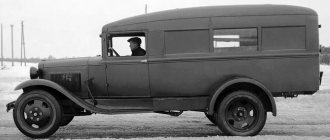Author: Vossen
March 17, 2016 11:40
Tags: GAZ 56 GAZ-51 gases history
3875
23
By the mid-thirties, the GAZ lorry, a licensed Ford AA, was outdated and there was a need for its replacement. Here it is - the bestial grin of capitalism: old Henry Ford, despite his ardent anti-communism, anti-Semitism and sympathy for the German National Socialists, all this did not stop him from cutting coupons from these same communists. However, the contract with Ford ended and Soviet designers developed the replacement for GAZ-AA themselves. Of course, they looked back at the Americans, but who didn’t look back at them back then!? Design of a new car with a six-cylinder in-line carburetor engine GAZ 11 with a power of 76 hp. s., which received the GAZ-51 brand, began in February 1937 under the leadership of designer V.M. Kudryavtseva. In June 1938, production of components began, in January 1939, assembly began, and already in May the first car entered road tests, which ended in July 1941. A number of sources call it GAZ-11-51, but in factory documents from the very beginning the car had the index “51” - the engine index did not appear in the names of GAZ truck models, unlike passenger cars of that time with the GAZ-11 engine, which were included in history with “11” in its index. In the summer of 1940, a prototype GAZ-51 was exhibited at the All-Union Agricultural Exhibition in Moscow. The second prototype, built in September 1940, after a run of 32,500 km, was equipped with a gas generator unit and worked at the plant for several more years. The tests were successful, and preparations began for serial production of the GAZ 51, which was to begin in 1942, at the beginning of the IV Five-Year Plan. But the outbreak of the Great Patriotic War disrupted these plans.
GAZ 11-51 Experienced '1939
0
Source:
Work on promising cars resumed in 1943. The rapid development of technology during the war years made inevitable adjustments to the design of the GAZ-51. Leading designer A.D. Prosvirnik (chief designer of the plant since 1968) radically reconfigured and modified the car, and essentially only the name remained from the pre-war GAZ-51. The accumulated experience in operating six-cylinder engines on combat vehicles has made it possible to significantly improve the engine and the systems that serve it. The carrying capacity was increased to 2.5 tons. However, the topic of the heir to the “lorry” was not abandoned.
0
Source:
0
Source:
GAZ - how the history of the domestic manufacturer was built
The Gorky Automobile Plant is an enterprise with a long history, which now occupies a central place in the segment of the domestic automobile industry. The manufacturer supplies the market with trucks, minibuses, power plants and special vehicles. In addition, the model line includes passenger cars. The history of GAZ begins in 1932. Then the enterprise had a different name - the Nizhny Novgorod Automobile Plant named after V.M. Molotov.
Photo: CAR.RU
The automobile plant, which is now known as GAZ, appeared as a result of an agreement between the Supreme Economic Council of the USSR and the Ford Motor Company. According to this document, the American side was supposed to provide technical assistance to the Soviet Union in the creation of cars and trucks. Ford A and Ford AA were used as donors for future models. The official opening of the plant took place on January 1, 1932. Just a month later, the first GAZ AA truck was produced.
In 1933, the first bus of the brand, GAZ-03-30, rolled off the assembly line of the plant. It could carry 17 passengers at once. The design included a wooden frame, which was additionally reinforced with metal sheathing. Despite the fact that the design turned out to be fragile, the bus became in demand for its time. Just 2 years after the start of production, the 100,000th copy of the GAZ-A model was released from the assembly line.
The history of the GAZ automobile plant begins in 1932
As part of the conclusion, the American side had to support the manufacturer from the USSR for 5 years. During this time, the company received documentation of the Model, which was produced in 1933. But such a transport was not suitable for use in the USSR, which is why it had to be rebuilt. “Emka” is the most popular car in the territory of the pre-war state. Based on it, the manufacturer has built several modifications. Just before the start of the war, the plant produced the GAZ-64 SUV model, which was distinguished by a high level of cross-country ability and the presence of an all-wheel drive system.
The Gorky Automobile Plant was engaged in the creation of tanks, namely the T-38. However, the initial model had many shortcomings. Therefore, after some time, a new project was created, called the “Molotov Tank”. Development in this direction was suspended in 1941. During the war period, such equipment as T-60, T-70, T-80, SU-76, BA-64 was produced. This period turned out to be not the easiest, as the plant was repeatedly bombed. Immediately after the end of the war, GAZ had to determine the direction of further development. This is exactly how the GAZ Pobeda M-20 appeared in 1946. A little later, a small GAZ-51 truck appeared on the market.
Molotov tank
After 2 years, the GAZ-63 rolled off the assembly line, and then the GAZ-69. The latter at the development stage had a different name - Worker. He managed to enter the market, but after a few years he went to UAZ. This model made a great contribution to the development of the automobile industry - a large number of modifications were created on its basis, and sales were carried out in 56 countries around the world. The manufacturer’s line included other well-known projects - ZIM, GAZ-21, GAZ-13, GAZ-2102.
The modern history of the enterprise begins in 1992. Immediately after this, the renewal of the model range began. GAZ-31029 began to be delivered with a modified design and rear part of the body. The modern version of the GAZelle appeared in 1994. After some time, he became a donor for the whole family. GAZ was not ready to abandon the Volga, so in 1997 it was updated. A major revolution in the history of the brand occurred in 2000, when the controlling stake was transferred to another company. The production facilities began to produce models of foreign brands - Mercedes-Benz, Volkswagen and Chevrolet.
Sable Next 4x4
The basis of the line in the new decade were GAZelles and cars for doing business. Now the manufacturer's line includes a wide range of cars, which, as a rule, are used in the commercial sector.
Bottom line. GAZ is a domestic manufacturer that has a long history in the market. Its appearance dates back to the 1930s. Despite difficulties such as war, the collapse of the USSR and the crisis, the plant maintained its position in Russia.
A very clear picture: “ancestor” and heir” - GAZ-AA and GAZ-51
0
Source:
After the Victory, it was decided to return to the topic of a small delivery truck, which the Soviet national economy was in dire need of. The Ulyanovsk Automobile Plant was the first to create a new “lorry”, which began developing its first own model, called the UAZ-300, back in 1947. Ulyanovsk residents presented the first copy of the promising “lorry” at a festive demonstration on November 7, 1949. The first version of the car's appearance was very similar to the GAZ-51, but in 1948 the factory workers developed an original and very successful design. What’s interesting is that there was no full-time artist-designer at the plant at that time! GAZ employees offered their own version of the appearance, but theirs turned out to be more attractive.
ZIS-150
The ZIS-150 of the first production was equipped with a wood-metal cabin
In 1947, the pre-war ZIS-5 was replaced by a completely new truck, the ZIS-150, with a load capacity of 4 tons. In many ways, the fate of the vehicle was similar to the GAZ-51. Even before the war, the designers of the Moscow Automobile Plant began developing a successor to the ZIS-5, but the truck took shape only two years after the end of the war. It is noteworthy that MosZIS was able to switch to production of a new truck, practically without stopping the conveyor. Mass production of the vehicle started on April 26, 1948.
During the war, many imported trucks, both German captured and American Lend-Lease, came to the Soviet Union. The latter had a particularly strong influence on the domestic design school. The ZIS-150 was radically different from the rustic ZIS-5, primarily in its appearance. It received an all-metal three-seater cabin with rounded contours. When creating the ZIS-150 cabin, the designers were inspired by the design of the American International KR11 of the early 40s. However, there was no talk of direct copying. In technical terms, the ZIS-150 has also gone far ahead. The truck received a new frame, a 5-speed gearbox, air brakes and a more powerful 90-horsepower engine.
Like Gorky's GAZ-51, the ZIS-150 (since 1956 ZIL-150) was actively used during the reconstruction of the country. In addition, it was the 150th that gave birth to the Chinese automobile industry ; in 1956, the country's first automobile plant began operating there. The ZIS-150 was produced for a relatively short time, only 11 years, and during this period the plant produced many modifications. In total, almost 800 thousand trucks were produced during this time.
UAZ 302 Experienced '11.1950
0
Source:
0
Source:
One of the reasons was that in 1951 the Ulyanovsk Automobile Plant was transferred to another branch of industry, under the jurisdiction of the USSR Ministry of Radio Industry, becoming for a time a radio plant. Developments on the UAZ-300/302 were transferred to the Gorky Automobile Plant.
0
Source:
In 1952, the design of a new “one and a half” GAZ-56 began. Development began under the leadership of Alexander Dmitrievich Prosvirnin. Since August 1954, Alexander Butusov, a recent graduate of the Gorky Polytechnic, became the leading designer of the machine. This was the first serious (after designing caravans) task for the young designer.
Gorky Automobile Plant
2000-2010
In November 2000, a controlling stake in OJSC GAZ was acquired by Oleg Deripaska.
In 2001, GAZ became part of the RusPromAvto automobile manufacturing holding, which, as a result of a radical restructuring in 2005, was transformed into the GAZ Group holding, where GAZ was assigned the role of the parent enterprise. Accordingly, all the Group’s products were distributed between divisions formed on a production rather than territorial basis. GAZ's specialization in the production of light and medium commercial vehicles was retained. According to the Group, it occupies a leading position in Russia in the production of light commercial vehicles. Already at the end of 2000, a major reorganization began at GAZ. Subsequently, a number of promising areas, including the program for the production of Ataman pickup trucks and SUVs, the GAZ-3115 segment D passenger car and a number of other projects were curtailed due to lack of financial resources and low marketing attractiveness. The dealer network was radically reorganized (in fact, it was created from scratch), a complete financial audit of the enterprise was carried out, and a number of non-core assets were transferred outside the framework of the JSC. These measures made it possible to first reduce unprofitability, and by the middle of the decade reach the level of profitability. The main attention was paid to the development of the most competitive area - light commercial vehicles with a gross weight of up to 3.5 tons (Light Commercial Vehicle), in the segment of which GAZ is actually a monopolist. In 2005, the company was able to master the serial production of a new family of low-load medium-tonnage trucks GAZ-3310 "Valdai", and the general economic recovery increased the demand for traditional medium-tonnage trucks GAZ-3307, 3309 and GAZ-3308 "Sadko". In 2005 and 2006, GAZ Group made significant efforts to overcome the technological and time gap from the world's leading manufacturers, while the experience of leading automakers was actively used to accelerate the development of new technology. The strategic goals of the GAZ Group included increasing the scale of its business and joining the club of global players in the international automotive market. GAZ Group focused its main attention on the segments of light commercial vehicles, E-class passenger cars and power units. The LCV division was increased in 2006 due to the acquisition by GAZ Group of the English company LDV Group, specializing in the production of lightweight front-wheel drive Maxus vans with a gross weight of up to 3.5 tons. In May 2008, GAZ began assembling vans and minibuses in Nizhny Novgorod Maxus from English SKD kits. With localization and the transition to CKD assembly technology, Maxus production volume was supposed to be 50 thousand per year, but due to the crisis and bankruptcy of LDV, the project never reached this stage and was discontinued in mid-2009.
Due to a conflict on engine prices with ZMZ in 2006-2008, part of the Volga, Sobol and GAZelle production was equipped with imported Chrysler 2.4 liter engines.
The Passenger Cars division carried out a restyling of the interior of the Volga sedans (31105 and 3102) in June 2007, but the drop in demand for the obsolete model range and the crisis forced GAZ to curtail the production of these models at the end of 2008. To develop the passenger model range, GAZ Group bought in 2006 from the DaimlerChrysler concern the Sterling Hills assembly plant, which produced mid-size Chrysler Sebring and Dodge Stratus sedans. Since July 2008, using equipment exported from the USA, the production of Volga Siber, its own E-segment model, has been organized. The production volume of Volga Siber was supposed to be 65 thousand per year, but the model turned out to be unpopular, and after the production of 8.7 thousand cars, the assembly was curtailed at the end of 2010.
In 2010, GAZ produced 70.3 thousand trucks (+78.1% compared to 2009). Through the dealer network of GAZ OJSC in 2010, 83.25 thousand trucks and buses were sold (+61.6% compared to 2009), including exports to more than 30 countries.
If GAZ's share in the production of LCVs and minibuses in the country is about 59%, then in the production of passenger cars its share fell to 0.4% and this is where the presence of the independent GAZ brand in the passenger car sector ended. However, the company returned to the passenger segment by assembling foreign brands Chevrolet, Volkswagen and Skoda.
In September 2008, GAZ faced a financial crisis, and since October - a sales crisis. In the fourth quarter of 2008 and in January 2009, GAZ stopped the conveyor several times in order to unload overstocked areas of finished products. Due to the emergence of serious debt to suppliers, as well as a bond offer in the amount of $147 million, in early February the Government of the Russian Federation decided to provide financial support to the GAZ Group.
In connection with the crisis, GAZ management took various anti-crisis packages of measures; for example, since the end of 2008, a shorter working week was introduced and staff was reduced (from 105 to 95 thousand). Despite the stop in November 2008 of the assembly line production of sedans 31105 and 3102 of the obsolete Volga family, it was planned to reduce their cost and, if there was demand, put them back into production. However, there was no renewal of demand and in the spring-summer of 2009 the passenger conveyor was dismantled, and in the future it is planned to assemble foreign cars on it. Plans for the production of the new Volga Siber model in 2009 were adjusted to 8 thousand, and later to 3 thousand; in fact, only 1,717 sedans were produced, of which 428 cars were sold. In 2009, Volga Siber was included in the list of domestic cars for centralized government procurement, but was not included in the official list of passenger models with subsidized loans for individuals. In 2010, Siber was included in the list of models included in the recycling program, due to which GAZ was able to produce the planned volume of 5.1 thousand sedans in 10 months of 2010 and curtailed their production on October 31.
On May 6, 2009, GAZ Group sold its British plant LDV Holdings, which belonged to the Russian concern for three years and produced commercial vehicles under the Maxus brand, to the Malaysian concern Weststar. Deliveries of Maxus assembly kits to GAZ were stopped in the same 2009, and the model was withdrawn from the Russian market.
To maintain sales of light commercial vehicles, GAZ developed a version of the Gazelle, reduced in price to $6,000, with a UMZ-4216 engine and a lightweight cab. However, the model was not in demand - only a limited batch of about 700 cars was produced.
On February 4, 2010, GAZ Group began serial production of the modernized families of light commercial vehicles "Gazelle-Business" and "Sobol-Business". Sales of modernized cars through the dealer network began on February 25, 2010.
On July 20, 2010, GAZ Group began serial production of a diesel modification of the Gazelle Business car.
At the end of October 2010, GAZ announced the start of production of a 4-ton version of the GAZ-33106 with a Cummins ISF 3.8 engine.
On October 31, 2010, production of Volga Siber ceased.
On December 23, 2010, the Daimler concern and the GAZ Group signed an agreement to organize the production of Mercedes-Benz Sprinter light commercial vehicles (W901-W905 series) at the Gorky Automobile Plant. Production of LCV began in 2013.
GAZ 56 Experienced (I series) '1953–54
0
Source:
The design of the car contained a number of technical solutions unusual for its time: sealed drum brakes, a cam-type self-locking differential, a continuous rear axle housing and a hypoid final drive, telescopic shock absorbers, an overhead shaft engine with pre-chamber-torch ignition of the combustible mixture and an electric coupling for the cooling system fan, springs without grease nipple on rubber bushings. The layout of the car was traditional - hood.
Modifications based on Gaz-AA
On the basis of the lorry, various fire engines, police vehicles, ambulances, radio stations, air defense light installations, detection radars and even armored vehicles were created.
Over the years of production, more than 1 million cars were produced.
PMG-1
1932—1941
Fire truck PMG-1 based on Gaz-AA
Fire truck PMG-1.
GAZ-03-30
1933-1941, 1945-1950
Bus Gas-03-30
Gas-AAA
1934—1943
Three-axle truck with a lifting capacity of 2 tons.
GAZ-410
1934—1946
Dump truck with a load capacity of 1.2 tons with an all-metal body and a self-unloading system.
Gas-MM
1938-1950
Modification with a 50 hp engine.
In 1938, the engine that was installed on the Gas-M1 passenger car was boosted. Thanks to a power increase of up to 50 hp. It became possible to install the engine on a truck.
In addition to the engine, Gaz-MM modified the mounting of the rear springs, the design of the steering mechanisms, etc.
GAZ-42
1938—1950
GAZ-43
1938—1941
GAZ-55
1938—1945
Military ambulance.
GAZ-44
1939
Gas cylinder truck based on GAZ-MM.
PARM-A
Repair and restoration vehicle.
History in letters
Allan Austin wrote to his parents and other relatives about his life and work every week, or even more often. His father kept these messages, and in 1998 they came to Allan’s son, Richard Austin. Inspired, he visited Nizhny Novgorod that same year and wrote a book about the creation of a car, based on letters from his father.
The book was published in the USA in 2004, and in Russian in 2017. First of all, this is a very cinematic depiction of the life of American engineers in a Soviet city, with all its sorrows and joys. Here they are setting up their rooms in panel houses in the “American village,” and Allan writes to his parents that he managed to build a fireplace screen with his own hands and it came out “quite well for the first time.” But Margaretta bought a 38-centimeter samovar at the local market (it is still kept by the Austins as a family heirloom), and also a bust of Lenin, which she installed in a place of honor on the mantelpiece - “as a sign of respect for the owners of the country.” First haircut in a new place (“haircut styles vary to the most crazy extremes”), first river walk along the Oka (“it was very pleasant”), problems with food (“the choice of meat is very poor: yesterday I bought a live chicken, what’s wrong easy to do”), longing for our native Cleveland (“we still need wicker chairs”).
But the value of the publication lies not only in its picturesque details, which are interesting for local historians and add color to the historical context. Perhaps the main thing in it is the author’s view of the experience of Russian-American relations - the implementation of a contract with a foreign partner, unprecedented for the USSR. A living story about how representatives of two nations are trying to build a dialogue based on universal human values, despite the difference in mentalities and the foreign policy coldness of the two countries. This was stated already in the very first contract that the Austin company signed with the State Bureau for the Construction of the Automobile Plant, Avtostroy. The agreement stated that in the event of any disagreements or difficulties, “the parties must resolve them through mutual efforts, in an atmosphere of friendship,” and without recourse to the courts.
The site on which the Gorky Automobile Plant was built. August 10, 1930
Photo: GAZ History Museum
“We consider it a privilege to have the opportunity to serve the Russian people and hope to make full use of it,” Allan Austin writes to his parents. “He did not share communist views regarding humanism, but was sincerely glad to have the opportunity to participate in a cause that could make people’s lives happier and more fruitful by creating completely new living conditions for them,” Richard Austin explains his father’s position in the book.











